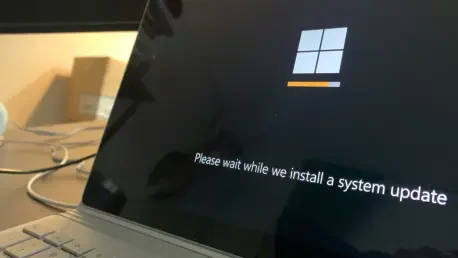Microsoft’s Patch Tuesday in June marks a notable event in cybersecurity, presenting updates that address 66 significant vulnerabilities across its extensive range of software products. This release is crucial not only due to the sheer number of flaws addressed but also because it includes solutions for two critical zero-day vulnerabilities. These vulnerabilities have captured attention within the tech industry, particularly because one is under active exploitation. This ongoing commitment by Microsoft to secure its ecosystem reflects a broader industry focus on prioritizing cybersecurity and implementing rapid patch management strategies. This growing emphasis underscores the importance of staying ahead in an ever-evolving threat landscape where prompt updates ensure the integrity and security of enterprise and consumer products alike.
Understanding the Impact of June’s Patch Tuesday
The Critical Nature of Zero-Day Vulnerabilities
The latest Patch Tuesday update by Microsoft is particularly significant due to the presence of two critical zero-day vulnerabilities. Among them, the one labeled as CVE-2025-33053 stands out. This vulnerability poses a grave threat, exploiting a remote code execution flaw within Microsoft’s Web Distributed Authoring and Versioning (WebDAV) service. Notably, the Stealth Falcon advanced persistent threat (APT) group has actively exploited this flaw, targeting defense organizations. WebDAV’s widespread use for managing web-based documents enhances the seriousness of this risk, as it can enable attackers to execute arbitrary code on compromised systems through specially crafted URLs. The exploitation of this vulnerability follows a sophisticated attack method involving malicious .url files that manipulate legitimate Windows tools to execute malware from servers controlled by threat actors.
In contrast, the second zero-day vulnerability, CVE-2025-33073, though not currently under active exploitation, carries substantial risk. This elevation of privilege flaw impacts the Windows SMB Client, allowing authorized attackers to gain SYSTEM-level privileges over networks by executing scripts designed to coerce machines into authenticating via SMB. Originating from research conducted by RedTeam Pentesting, the vulnerability highlights potential risks within internal network security. It necessitates external awareness and immediate patching to mitigate the possibility of unauthorized privilege escalation, which could lead to significant breaches within organizational networks.
A Broad Spectrum of Vulnerabilities Addressed
Beyond the immediate concerns of zero-day vulnerabilities, the Patch Tuesday release addresses a wide spectrum of other vulnerabilities, providing a comprehensive protective layer. Among the variety of risks mitigated, remote code execution vulnerabilities emerge as a predominant concern, with 25 identified instances. These vulnerabilities pose the risk of unauthorized control over affected devices, underscoring the necessity for prompt updates to prevent potential exploitation. Additionally, there are 13 elevation of privilege vulnerabilities identified that could allow attackers to elevate access levels, gaining permissions typically reserved for high-level administrative functions.
Furthermore, 17 information disclosure vulnerabilities are included, highlighting the risk of sensitive information leakage, which could compromise both privacy and security. Six denial of service vulnerabilities, aiming at disrupting services and system availability, are addressed, along with three security feature bypass vulnerabilities. The latter poses threats to established security measures, allowing potential circumvention. Finally, two spoofing vulnerabilities are identified. These vulnerabilities could allow attackers to impersonate legitimate systems or services to execute attacks, adding another layer of complexity to the myriad risks being addressed in this comprehensive release.
Innovations in Microsoft’s Patch Strategy
Enhancements in Microsoft Office and SharePoint
The June updates reflect detailed attention to the protection of widely used applications, particularly Microsoft Office, recognizing their critical role in business operations. The release addresses various remote code execution fixes, including vulnerabilities that could lead to local code execution through heap-based buffer overflow without user interaction. By addressing these vulnerabilities, Microsoft underscores its commitment to preventing potential breaches in productivity software essential to business environments. Moreover, significant updates are implemented for the SharePoint Server, ensuring that this vital enterprise tool remains secure and protected against potential compromise within collaboration environments.
The proactive approach to patching productivity tools exhibits Microsoft’s acknowledgment of their importance within enterprise settings. As these applications are integral to daily operations, ensuring their security strengthens overall enterprise resilience against potential threats. The updates for these widely used applications not only provide a layer of protection but also reinforce the preventative measures organizations must consider to safeguard their essential tools and data.
Strengthening Core Windows Components
In addition to application-specific updates, June’s Patch Tuesday highlights a concerted focus on strengthening core Windows components, a key strategy in maintaining system integrity and network security. Notable updates for Windows’ KDC Proxy Service (KPSSVC) address a use-after-free vulnerability, which could lead to network-based code execution. Addressing such vulnerabilities is crucial in preventing potential breaches and ensuring the integrity of network services. Similarly, patches for Windows Netlogon address elevation of privilege vulnerabilities, while updates for Remote Desktop Services aim to mitigate threats from remote execution.
A particularly critical inclusion is the update for the Schannel component, responsible for overseeing secure communications. Its patch is vital for maintaining the cryptographic service integrity within Windows, a cornerstone to safeguarding sensitive data and communications. These updates exemplify Microsoft’s efforts to ensure the foundational components of their operating system remain robust against evolving cyber threats, providing a stable and secure platform for enterprise and individual users.
Recommendations for Organizations and IT Administrators
The Role of Security Researchers
The continued vigilance displayed by Microsoft is complemented by significant contributions from security researchers who play a crucial role in uncovering and highlighting vulnerabilities. The collaborative efforts with research entities like Check Point Research and RedTeam Pentesting have been instrumental in identifying critical vulnerabilities. Their insights have not only prompted timely patches but also helped reinforce industry best practices. Encouragingly, Microsoft’s approach aligns with these practices, emphasizing the immediate deployment of critical patches, particularly for internet-facing systems and domain-joined devices.
The role of security researchers is integral to maintaining a secure digital environment. Their continuous efforts to discover potential vulnerabilities and collaborate with companies like Microsoft exemplify the proactive measures necessary to combat the sophisticated nature of modern cyber threats. As threats continue to evolve, the collaborative dynamic between security researchers and technology companies ensures a fortified and responsive defense strategy, vital to navigating the complexities of the cybersecurity landscape.
Strategic Advisory for IT Administrators
Organizations must heed the advisories stemming from June’s Patch Tuesday updates, prioritizing installations of specific updates, especially those addressing actively exploited vulnerabilities. Of urgent concern is the WebDAV zero-day vulnerability (CVE-2025-33053), given its threat to systems with internet exposure. The critical need for immediate action cannot be overstated, as exploitation continues to affect targeted industries. Additionally, the SMB vulnerability (CVE-2025-33073), representing potential risks to internal network security despite being non-exploited presently, warrants prompt attention to mitigate any future impact.
Implementing strategies such as network segmentation adds an additional defensive layer against potential exploit attempts. By segmenting networks, organizations can limit the spread of any potential breaches, reducing both the risk and impact of attacks. IT administrators should remain vigilant in monitoring updates and ensuring swift deployment of critical patches. Maintaining a proactive approach ensures the sustainability of defenses against cyber threats and underscores the importance of strategic planning to navigate the dynamic landscape of security challenges.
Reflecting on Microsoft’s Commitment to Cybersecurity
The Broader Implications of Patch Management
June’s Patch Tuesday release serves as a testament to Microsoft’s unwavering commitment to fortifying cyber defenses across its extensive suite of products. Through diligent patch management, the company addresses immediate risks posed by critical and zero-day vulnerabilities while strengthening the overall security infrastructure that myriad systems and applications depend upon. This proactive dedication is reflective of an industry-wide shift towards preemptive cybersecurity planning, essential in ensuring robust defenses against an array of digital threats.
The continued emphasis on rapid and thorough patch management not only mitigates current vulnerabilities but also establishes a foundation for future security enhancements. As cyber threats grow increasingly sophisticated, the ongoing collaboration between Microsoft and security researchers worldwide highlights an evolving strategy centered on resilience. This approach ensures that systems remain secure in the face of advancing adversaries, underscoring the industry’s commitment to safeguarding digital environments in a constantly changing landscape.
Embracing Future Security Considerations
Microsoft’s most recent Patch Tuesday update holds significant importance due to the discovery of two critical zero-day vulnerabilities. Chief among them is CVE-2025-33053, which presents a severe threat by exploiting a remote code execution vulnerability within Microsoft’s Web Distributed Authoring and Versioning, or WebDAV, service. This service is commonly used for managing web-based documents, and its prevalence adds to the potential danger posed by this flaw. Particularly concerning is that the advanced persistent threat group Stealth Falcon has been actively exploiting this vulnerability. Targeting defense organizations, they utilize sophisticated methods involving malicious .url files, which manipulate legitimate Windows tools to execute malware from servers they control.
Additionally, the second zero-day vulnerability, CVE-2025-33073, though not yet actively exploited, still poses significant risks. This flaw facilitates an elevation of privilege within the Windows SMB Client, enabling attackers with access to gain SYSTEM-level privileges. By executing scripts that coerce systems into authenticating via SMB, unauthorized users could compromise internal security. This vulnerability was identified by RedTeam Pentesting and emphasizes the importance of immediate patching. Failure to do so could lead to privilege escalation, resulting in serious security breaches across organizational networks. External awareness and prompt action are crucial to safeguard against these potential threats.









